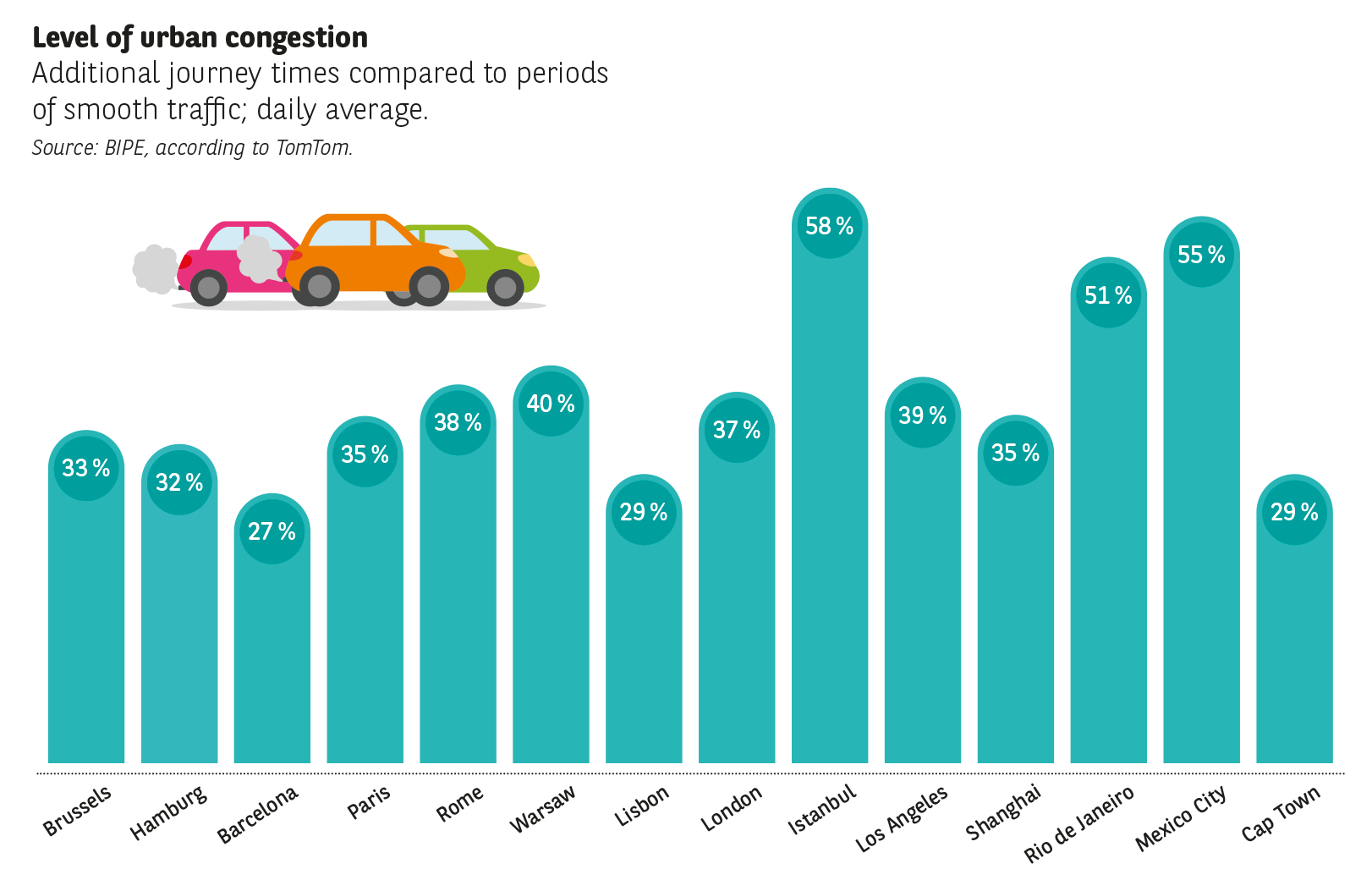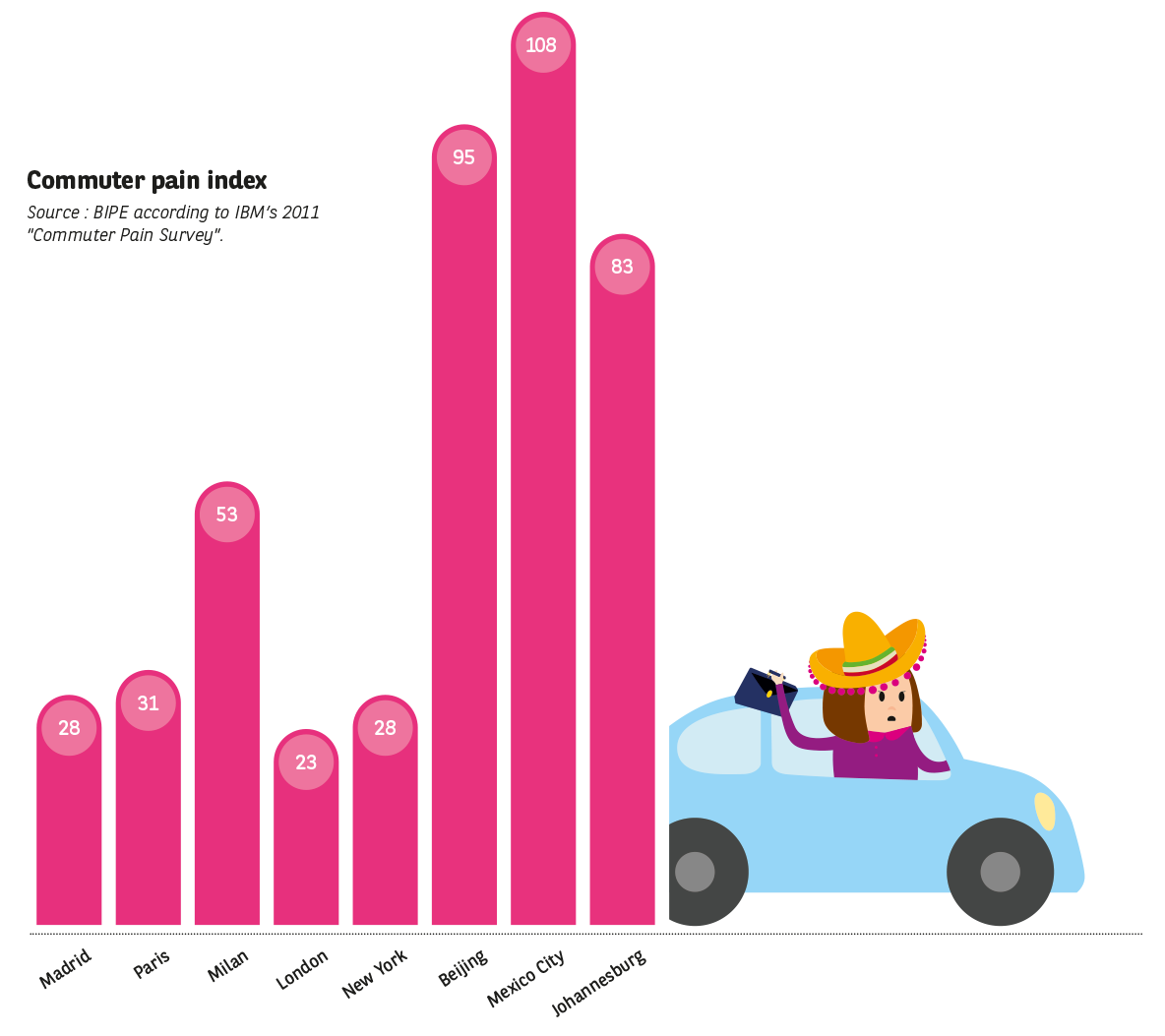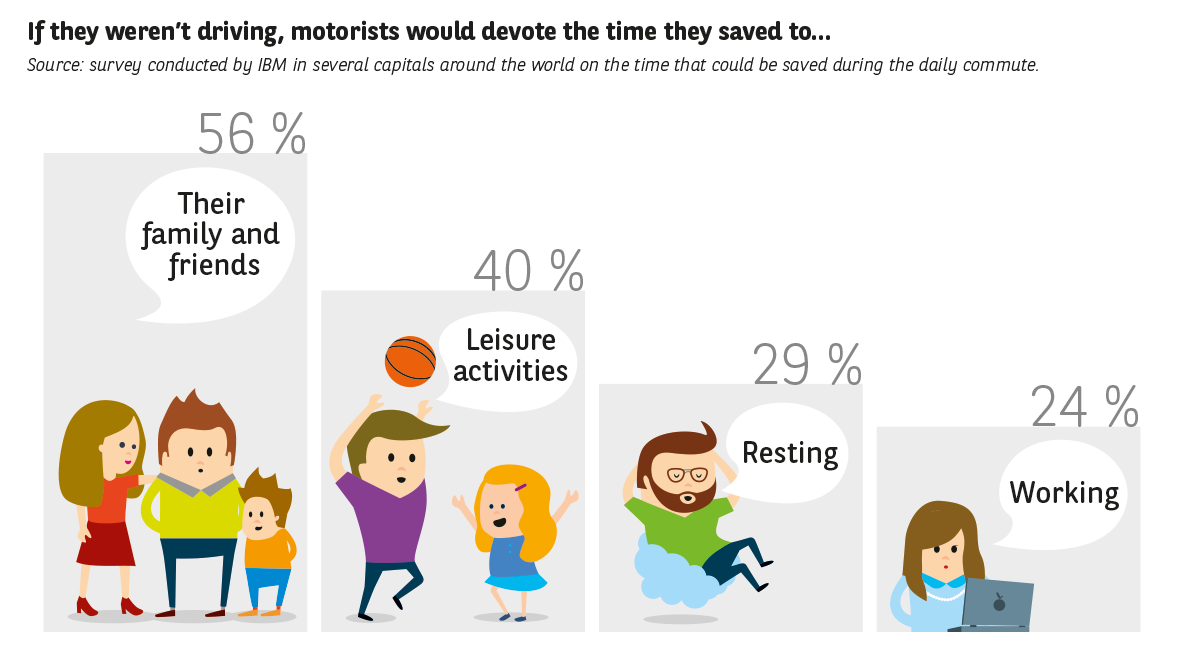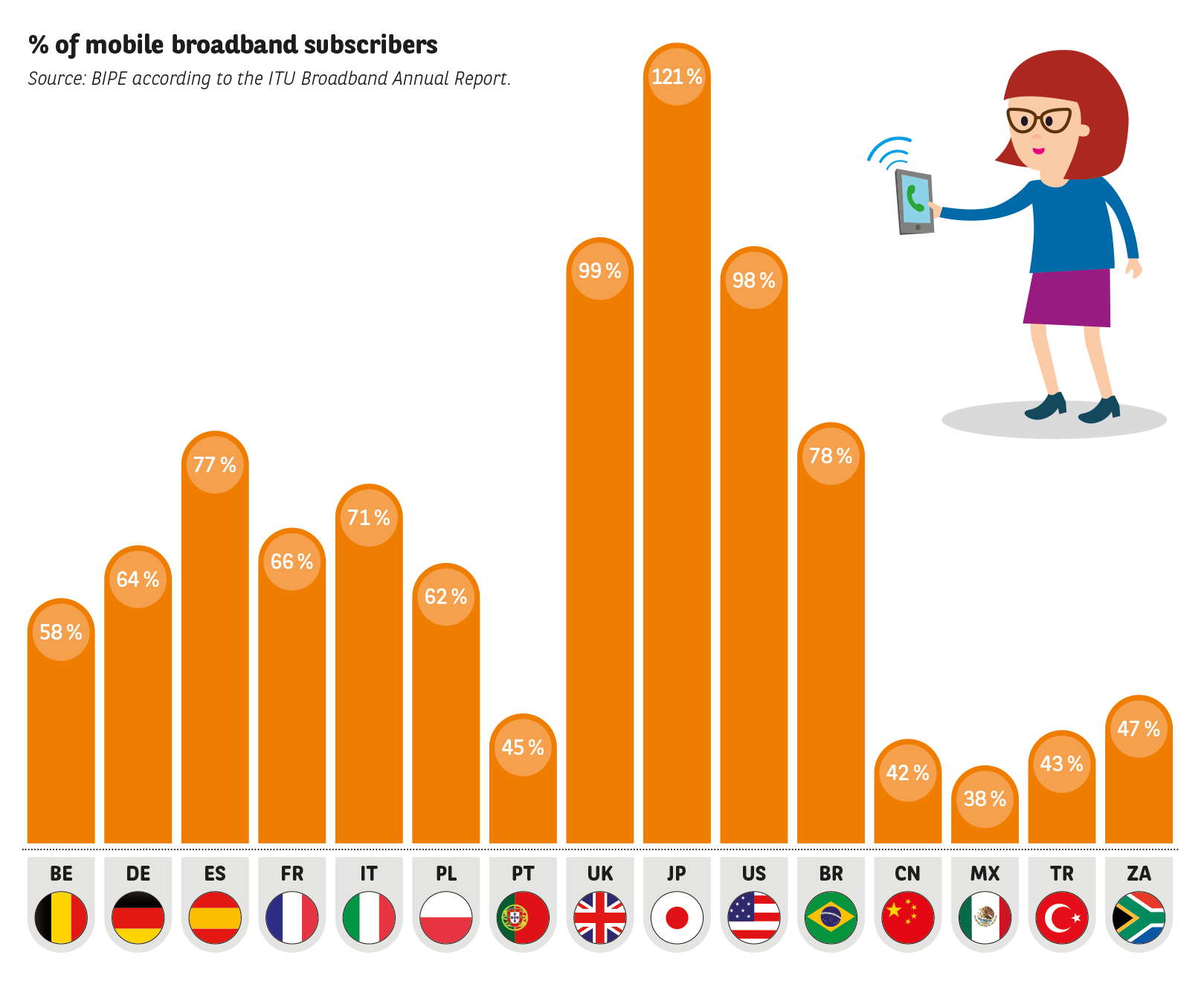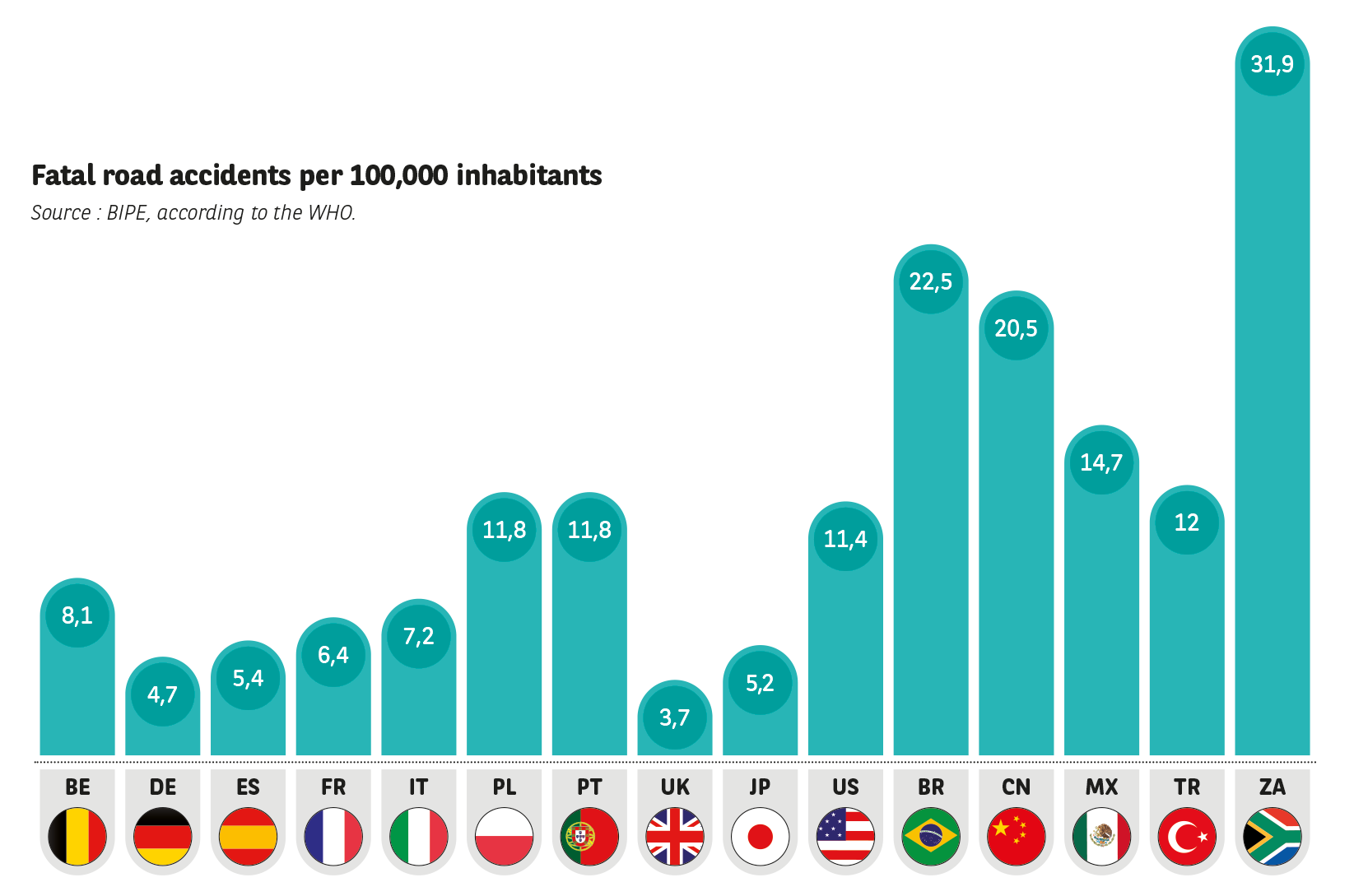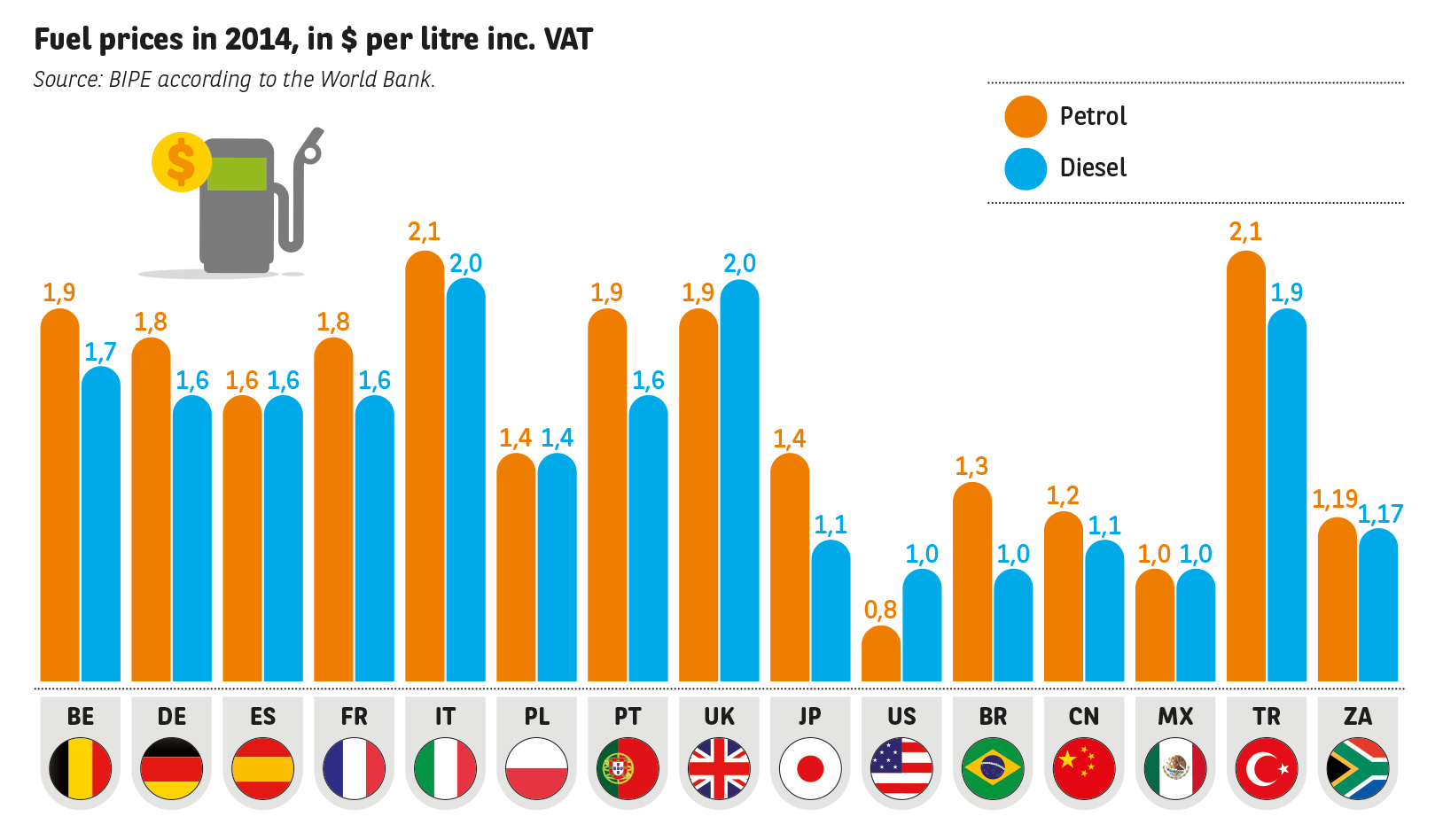LIFESTYLES: NEW DRIVING BEHAVIOURS
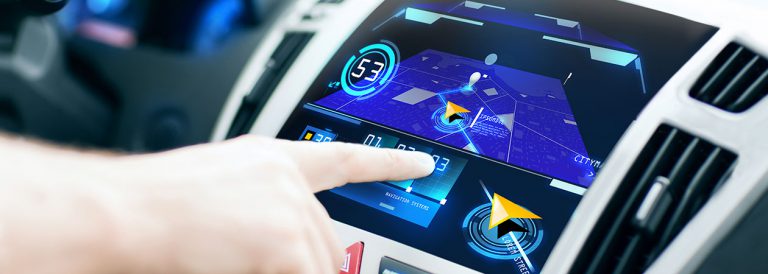

A different way of motoring
Every era has its advances! We no longer drive in the way we used to, and technology has a lot to do with it.
Journey optimisation
Most connected cars include a satellite navigation system that tells the driver which route to take to reach a given destination and the time at which they will arrive. The vehicle’s progress and real-time traffic conditions are taken into account thanks to the information supplied by the road networks, vehicle fleets, other drivers who use smartphones, weather forecasting services and the vehicle’s speed sensors.
180 million subscribers used a real-time navigation application on their smartphone in 2013, but the line between mobile navigation and the integrated systems fitted to vehicles has vanished thanks to services such as CarPlay and Android Auto, which are specially designed to fit seamlessly into a car’s dashboard.
Navigation functions allow drivers to optimise their travel times, plan their journeys, choose between different routes, warn others if they will be late, save their favourite journeys or modify their route.
Fig. 2 Level of urban congestion
Additional journey times compared to periods of smooth traffic; daily average.
Source: BIPE, according to TomTom.
Delegating duties to your car
Delegating some or all driving tasks to your vehicle will make car travel more efficient, while also making road traffic smoother. It is currently estimated that 30 % of the time spent in traffic in the world’s large cities is due to drivers looking for parking spaces. The ability to fully delegate this part of a journey will soon be a reality. This will contribute to reducing urban congestion (Fig. 2) and will mean precious time savings for motorists. The driver will step out of their car at the entrance to a car park, leaving the vehicle the task of locating an empty space and parking itself.
According to TomTom, urban road congestion can increase average daily journey times by almost 60 % in some cities, a figure that can reach 100 % during the evening rush hour.
In a world of fully autonomous vehicles, cars will coordinate with their environment to reduce the main sources of congestion: inappropriate driving behaviour and road accidents. There will be greater synchronisation when it comes to speed, braking, lane changes and overtaking, with the delegation of driving tasks ultimately helping to improve traffic fluidity for road users.
Motoring for all
A fully autonomous car with no steering wheel or pedals, with passengers but no driver. While Google’s dream will require a great deal of technological prowess if vehicles are to make complex decisions autonomously in all traffic conditions, it also paves the way for new forms of automotive mobility and entirely new possibilities in this area.
The appearance of vehicles that need no human intervention will enable more people to return to their cars (the elderly) or gain access to automotive mobility (the visually impaired, as well as children and those without a driver’s licence). Unlike trains, autonomous cars will take their passengers where they want to go, when they want to go.
The deployment of robot cars could make urban mobility more automotive, but with fewer vehicles. Several studies, notably that conducted in Lisbon by the OECD, suggest that fleets of robot vehicles could eventually be used for all journeys traditionally performed using private cars, taxis and even public transport. By optimising routes and travel times, robot vehicles would be able to transport several people at a time or in succession. These vehicles would almost never be stationary and would allow many households to do away with their car, thus reducing the need for parking spaces, freeing up road space for other purposes and cutting urban congestion.
No longer driving also means being able to devote travel time to countless other activities: social interaction, work, relaxation, leisure, etc. The daily commute is a source of stress that affects the health and productivity of employees. The survey conducted by IBM (Fig. 3) in several capitals around the world indicates that drivers in emerging countries are generally more likely to declare that they get stressed or angry behind the wheel.
However, not all motorists are keen to give up driving: 77 % of the individuals surveyed for the 2013 edition of L’Observatoire Cetelem stated that they “love driving”.
Fig. 3 Commuter pain index.
Source: BIPE according to IBM’s 2011 “Commuter Pain Survey”.
The index takes into account various “pain” factors calculated and experienced by commuters:
Average commuting time
Time stuck in traffic
Perception of petrol prices
Perception of changes in traffic conditions
Sensitivity of drivers to stop/start traffic
Stress when driving
Anger when driving
Impact of traffic on professional work
Proportion of drivers who decided not to make the trip due to traffic.
A personalised, comfortable and entertaining environment
Every driver is unique and aspires to develop their individuality.
Access to personalised geolocation-based services
With connected vehicles, the development of geolocation-based services has only just begun. These services will become increasingly personalised as the habits and preferences of motorists are better understood. Embedded technologies, biometric sensors and in-car cameras will make it possible to suggest applications based on behavioural analyses.
Motorists will be able to search for information using their navigation systems, allowing them to easily locate services that may interest them along their route or around their final destination: service stations, garages, restaurants, hotels, points of sale, tourist sites, theme parks, cultural venues, airports, stations, etc. They will find it easier to access additional information and choose alternative routes depending on criteria more subjective than distance or speed, such as the beauty of the scenery, thanks to geotagged images and information.
Receiving targeted offers
Motorists will be able to choose to receive marketing offers that reflect their needs or habits, or which are tailored to their vehicle’s requirements. Thanks to “contextual advertising”, connected vehicles will become a new point of contact between consumers and their favourite brands and stores.
Based on the data they supply, motorists will, for example, be able to receive information
about restaurants that offer options tailored to their personal requirements (vegetarian, children’s menus, etc.) or hotels with rooms available for the number of people travelling in the car. Based on the data sent by the car, a vehicle service centre may suggest an appointment nearby to change a worn set of tyres.
This sharing of data obviously raises the question of confidentiality, because the technologies that make car travel more entertaining are also capable of generating a vast quantity of data about motorists, which can reveal a great deal about their behaviours and habits.
Communication, entertainment and relaxation
With a fully autonomous vehicle, the time spent travelling could be entirely devoted to various other pursuits, depending on the preferences or lifestyle of its occupants (Fig. 4).
Giving up driving will boost an individual’s personal and social well-being, while significantly reducing their stress levels.
Fitting a car with an internet connection transforms it from being just a break in the day into a gateway between connected spaces and objects such as the home, the workplace and smartphones. Turning a car into a Wi-Fi hotspot (Fig. 5) allows its occupants to connect to the web using the mobile device of their choice, enabling them to enjoy their usual online activities.
Fig. 4 If they weren’t driving, motorists would devote the time they saved to…
Source: survey conducted by IBM in several capitals around the world on the time that could be saved during the daily commute.
Fig. 5 % of mobile broadband subscribers
Source: BIPE according to the ITU Broadband Annual Report.
The key to greater road safety
Towards an end to road traffic accidents.
Safety is at the heart of our preoccupations
According to the World Health Organisation, road accidents are responsible for 1.2 million deaths each year, while the number of people injured is estimated at 50 million worldwide (Fig. 6).
A sizeable challenge therefore lies ahead for manufacturers and suppliers of vehicle telematics solutions. With more than 90 % of accidents caused by human error, the proliferation of driver assistance technologies, and eventually autonomous cars, promises a great deal in terms of road safety. Car makers such as Volvo have even gone as far as setting themselves the target of zero deaths on board their vehicles by 2020. Google believes that road fatalities could be halved thanks to autonomous vehicles.
Fig. 6 Fatal road accidents per 100,000 inhabitants
Source: BIPE, according to the WHO.
“A computer at the wheel makes safety real!” is the fully autonomous vehicle’s bold claim
Fully automated cars mean no driving under the influence, no tired motorists falling asleep at the wheel and no distracted drivers either. Because, in theory, they mean no drivers at all.
Fully autonomous cars appear to be the most popular way of combating road traffic deaths, through the reduction of human error. As air and rail travel have already demonstrated, the introduction of automated systems considerably reduces accident frequency. Thus, according to Google, despite travelling more than 1.6 million kilometres, no accidents have been caused by Google Cars operating in automatic mode. The only accidents recorded took place when the vehicles were in manual mode.
A dream that will remain remote as long as driverless and human-controlled cars co-exist
Indeed, fully autonomous cars in their most advanced form are not for the immediate future: for now, the regulatory frameworks of many countries require the driver to keep their hands on the wheel, thus implying that driver aids, regardless of their degree of intelligence, cannot completely replace human drivers, who can be held liable in the event of an accident. Initially therefore, drivers will need to stay vigilant and be available to perform certain key functions and quickly regain control in the event of a problem.
Thus, there will inevitably be a transitional phase during which driverless and human-controlled cars have to co-exist. But this phase will not be without its dangers, as fully autonomous vehicles will struggle to predict the sometimes erratic, sudden and potentially hazardous behaviour of human drivers.
Drivers under the spotlight
When it comes to improving road safety, eco-driving has already proved its worth: the data produced by companies whose employees have received such training indicates a significant drop of around 15 % in the number of accidents. Connected cars are able to constantly provide drivers with information about their driving behaviour and, more importantly, warn them when their actions pose a risk.
Meanwhile, systems to check whether the driver is fit to drive are seeing increasing use in vehicles. Excessive alcohol intake, drug use, tiredness… the latest generations of in-car equipment will be able to alert the driver regarding their aptitude to drive before they start their vehicle, not to mention freezing the vehicle’s controls in the event of dangerous behaviour and warning other road users of a problem.
In the long term, cars could even resemble medical diagnosis centres. Semi-automated vehicles will use sensors to detect changes in heart rate or body temperature, for instance, triggering additional safety or assistance systems if necessary. Lexus has gone as far as developing a concept vehicle whose electroluminescent paint pulses in time with the driver’s heartbeat. This
“Heartbeat Car” would also be able to warn other motorists or passers-by that the driver is about to have a cardiac arrest.
In addition, the ability to call the emergency services while also providing a partial trauma assessment would be a priceless development. All new cars sold in the European Union will have to be equipped with eCall technology as of April 2018. Designed to be triggered in the event of a crash, the system communicates the vehicle’s exact location to the emergency services immediately and automatically, regardless of the state of health of the passenger(s).
Managing both the driver’s emergency medical requirements and the vehicle’s mechanical needs
Anticipating vehicle faults through preventive maintenance
Upkeep and safety go hand in hand: a well maintained vehicle is less likely to break down, and even to have an accident, because it responds better in critical situations. In a connected car, curative maintenance is replaced by preventive maintenance, which is achieved through constant and direct communication between the vehicle and the manufacturer or the garage responsible for its upkeep. Data relating to safety and component wear is forwarded automatically, allowing the vehicle to be repaired remotely or, at the very least, informing the driver of any maintenance required to prevent a breakdown. The widespread deployment of the 4G standard will facilitate the development of predictive maintenance applications: Indeed, AT&T and GM have announced an agreement that allows a 4G connection to be incorporated into new vehicles.
The connected car transforms the relationship between the driver, the dealer network and after-sales services: when the vehicle determines that it needs a service or that a part needs replacing, it can connect the driver directly to a garage so as to arrange an appointment.
This marks a sea change for people’s vehicle budgets
Autonomy brings financial savings
Saving on fuel is child’s play
The widespread deployment of automated motoring and related geolocation services will reduce vehicle fuel consumption and therefore cut household travel costs (Fig. 7).
In a world of autonomous vehicles, cars will do everything possible to prevent infrastructure congestion: they will adjust their route to avoid creating traffic jams and, if they find themselves in dense traffic, will never brake suddenly and cause the formation of stop-start traffic. Automated motoring will favour travel at intermediate speeds, which are the most fuel efficient, and will minimise re-acceleration phases, which consume the most energy.
Furthermore, autonomous vehicles will automatically govern engine acceleration, avoid excessive engine speeds, take into account the journey’s topographical features so as to manage upward and downward slopes, anticipate obstacles sufficiently in advance to be able to slow down smoothly, as well as driving in convoy to make the most of slipstreaming. All these autonomous driving styles will save fuel. A reduction in the number of road accidents will also herald the introduction of new generations of bodywork, which will be lighter due to the removal of their protective parts and will therefore cut fuel consumption.
According to the University of Maryland’s National Renewable Energy Laboratory (NREL), optimised driving would reduce fuel consumption by around 15%, while greater coordination between vehicles at intersections could increase fuel efficiency by 30 %.
Another positive effect of reducing fuel consumption would be the improvement of air quality due to fewer pollutant emissions. An advantage that should prove highly appealing to the inhabitants of the most polluted cities.
Fig. 7 Fuel prices in 2014, in $ per litre inc. VAT
Source: BIPE according to the World Bank.
A gradual fall in insurance premiums
In a world of autonomous vehicles, motorists will pay less for insurance because the overall cost of car insurance claims will drop. However, vehicles will still need to be insured against failures in their equipment and digital systems, and probably also against remote computer hacking, but these are not risks for which the vehicle’s occupant will be held liable.
In the years leading up to this new era for car insurance, motorists will experience another cost-saving revolution. Connected vehicles will make usage-based insurance (UBI) a reality, whether it be PAYD (pay as you drive) or, more crucially, PHYD (pay how you drive).
The safest drivers will be able to reduce their insurance premiums thanks to a risk calculation that takes into account personalised criteria. This type of contract will also encourage less risk-aware drivers to be more careful at the wheel. With connected vehicles, the potential number of individual criteria included in the risk calculation could be huge: actual distance travelled, driving style, speed around bends and with respect to surrounding traffic or weather conditions, but also the types of road used, the driving mode selected (autonomous or other) and tyre pressures. Reducing insurance premiums therefore comes at a price: motorists must agree to supply all this new data.
Limited, but closely-controlled maintenance.
Savings through maintenance. The lifetimes of autonomous vehicle will be maximised and the overall cost of car travel reduced. Motorists will be better informed, allowing them to manage their expenses more effectively. Thanks to the information and diagnostics provided by their connected vehicle, they will almost become experts on its state of health. This will also reduce the risk of being advised to have unnecessary or expensive repair work carried out.
Advanced solutions for budget management
Based on real-time information, special tools and applications will make it easier for motorists to make decisions about their budget. A detailed rundown of all vehicle expenses incurred will be provided by the car (fuel, maintenance, parking, tolls, mileage taxes, as well as loan repayments and insurance premiums). Additional functions will allow access to the best commercial offers available near the route being taken, including service stations and other types of product or service in which the driver will have expressed an interest.
For some, the best possible budget decision will simply be to pay for car-sharing and other types of service, with the proliferation of car-share fleets and autonomous taxis meaning that they no longer need to own a vehicle. For others, ride sharing or private car sharing will lead to a reduction in their automotive expenses, thanks to the simplification of such schemes.
As for those motorists who still wish to make a purchase, the cost of buying an autonomous car will probably be higher than that of current vehicles, given the considerable amount of smart systems they will contain. Unless the buyer chooses to partially finance the vehicle or its use through contextual advertising.

